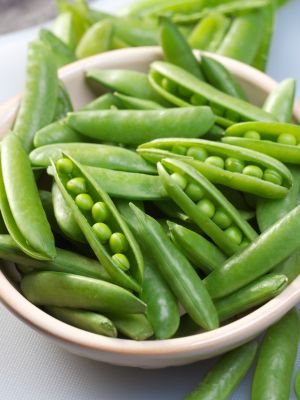
reference-image, l
(article, Catherine Bennett Dunster)
[%pageBreakSettings nobreak=true] p(blue). Editor's note: Catherine Bennett Dunster wrote the Health+Food column from June 2007 to April 2008. "I was just diagnosed with prediabetes. My nurse practitioner said that it will likely become Type 2 diabetes if I continue my trend of gaining weight, even if it’s only a few pounds a year. Obviously, diabetes is something I’d like to avoid. Can you tell me more about this? What should I be eating?" A prediabetes diagnosis is an excellent reason to make changes in order to prevent the progression to Type 2 diabetes. In prediabetes, the blood-glucose levels are abnormally high, but not quite high enough to be Type 2 diabetes. Unfortunately, according to the American Diabetes Association, long-term damage to the body — especially the heart and circulatory systems — is already occurring during prediabetes, so addressing the problem now is important. [%image peas float=left width=300 caption="Eating to avoid diabetes? Choose seasonal vegetables and other whole foods."] There are two types of diabetes: Type 1 and Type 2. Type 2 diabetes — affecting nearly one in four Americans — is a chronic metabolic medical condition and is by far the most common kind of diabetes. People with Type 1 diabetes, also known as "juvenile diabetes," no longer produce insulin. People with Type 2 diabetes still produce insulin, but either they don’t produce enough insulin or their bodies are unable to use the insulin they do produce in the same way they would in a healthy, non-diabetic state. The latter is called insulin resistance, and is a hallmark of Type 2 diabetes. Glucose is your body’s major fuel for energy, and insulin is what makes it possible for your cells to use this energy source. When you consume food, your body breaks down starches and sugars into glucose. Insulin then acts to open your body’s cells to allow the blood glucose into the cells to do its work — again, fueling all that your body does. [[block(sidebar). h1. Diabetes online To learn more about prediabetes and Type 2 diabetes, the American Diabetes Association is an excellent resource. ]] When there is a lack of insulin or the cells ignore the insulin (as in the case of insulin resistance), the glucose accumulates in the blood. Initially, your cells receive inadequate energy; over time, the high blood glucose can damage your heart, kidneys, eyes, and nerves, causing secondary complications. Many adults put on a few extra pounds each year. This happens for a variety of reasons: decreased activity levels, metabolic changes with aging, and go-go lifestyles that squeeze out time for thoughtful meal planning, among other things. As you’ve found, that additional weight becomes problematic for some people over time. Being overweight is a primary risk factor for Type 2 diabetes. According to the American Diabetes Association, weight loss will help you by lowering your body’s resistance to insulin and thus allowing insulin to better lower your blood-glucose levels. Also, weight loss improves blood pressure and blood-fat levels. Since diabetics are about twice as likely as non-diabetics to get heart disease, weight loss — if you are overweight — is a good idea. The best news? Even modest weight loss has been shown to be beneficial in Type 2 diabetics. h3. Nutrition tips Get moving. Physical activity helps insulin to work better in your body, uses up excess sugar in your blood, and facilitates weight loss. Though that’s technically not a nutrition tip, I find that those who adopt a routine exercise program are more motivated to tackle dietary changes (and stick with them!). Find activities you enjoy, and do them vigorously on a regular basis. Of course, consult your health-care provider for prior approval. Seek variety, balance, and moderation in your food choices. And keep your portions appropriate. Headline-grabbing it’s not, but sensible eating has outlived many a fad diet. Keep it real. Yes, the supermarket is full of items labeled especially for diabetics and plenty of products laced with non-calorie or low-calorie sugar substitutes. But real, whole foods generally provide more in the way of overall nutrition and are hands-down more satisfying. Living on a diet of highly processed and artificially flavored foods provides minimal nutrients and even less taste. Instead, choose seasonal fruits and vegetables; whole grains; dried beans, lentils, fish, shellfish, and lean meats for protein sources; and non-fat or low-fat dairy products as the foundation of your diet. Cut the fats. Minimize foods high in saturated fats, like fatty meats, poultry skin, full-fat dairy products, and fat-rich desserts. Choose cooking methods that don’t add much fat: poaching, baking, grilling, broiling, or roasting. Avoid fried foods. Pick healthy vegetable oils such as olive and canola (and there are many more, depending on your needs). And if you’re still eating anything laden with trans fats, quit now! Plan ahead. Most people want to do the right thing, but are often tripped up by lack of planning. Stock your refrigerator and cupboards with foods you enjoy, and give some thought every week to meal planning. Adopting some very simple routines can not only save you time but will also bring you appetizing meals as the week unfolds. Kelly Myers shares some great ideas for advance planning and cooking. Finally, I would strongly recommend a personal consultation with a registered dietitian for help in designing a healthy eating plan specifically tailored to you, your food preferences, and your nutrition goals. A dietitian can determine your total calorie requirements; recommend amounts of protein, fat, and carbohydrates; and assist you in planning your meals. For help in locating a qualified nutrition professional in your area, visit the American Dietetic Association website. p(bio). Catherine Bennett Dunster is a registered dietitian and a former instructor at Oregon Health and Science University. She lives with her husband and two children in Portland, Oregon.

reference-image, l

peas, l